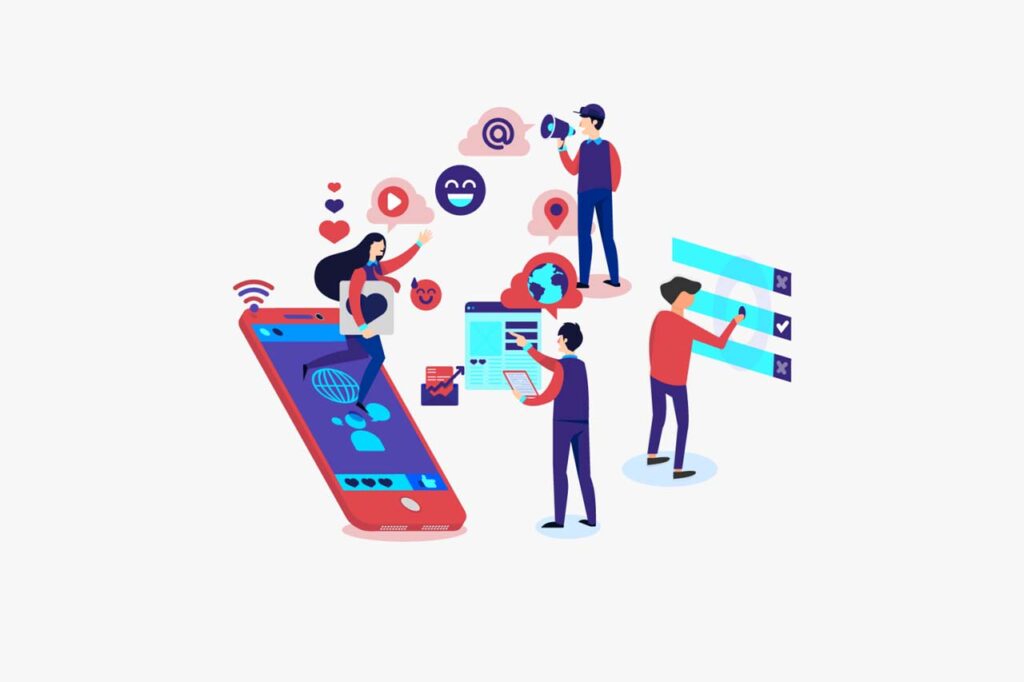
Picture this: You’re standing at the threshold of a digital revolution for your business. The air is thick with anticipation, and your mind is buzzing with ideas. You’ve decided it’s time to elevate your online presence, and you’re ready to partner with a web design agency to bring your vision to life. But here’s the million-dollar question – how do you ensure this collaboration is a smashing success?
As someone who’s been in the trenches of web design for years, I can tell you that the secret sauce to a stellar website isn’t just about flashy graphics or cutting-edge technology. It’s about forging a rock-solid partnership with your web design team. Think of it as a digital tango – it takes two to create something truly magical.
In the bustling tech hub of Los Angeles, where innovation is as common as palm trees, finding the right web development company can feel like searching for a needle in a haystack. But fear not! I’m here to guide you through the ins and outs of building a collaborative relationship that’ll make your competitors green with envy.
So, grab your favorite beverage, get comfy, and let’s dive into the art of collaboration. By the time we’re done, you’ll be armed with the knowledge to turn your web design dreams into a pixel-perfect reality. Ready to embark on this exciting journey? Let’s roll!
Setting the Stage for Success
Before we dive into the nitty-gritty of collaboration, let’s set the stage for success. Think of this as the foundation of your digital skyscraper – get it right, and you’re halfway to the clouds already.
Defining Your Vision and Goals
First things first, you need to have a crystal-clear vision of what you want to achieve. It’s like planning a road trip – you wouldn’t just hop in the car without knowing your destination, right? The same goes for your website project.
Take some time to ponder these questions:
- What’s the primary purpose of your website?
- Who’s your target audience?
- What kind of vibe do you want your site to give off?
- What specific features or functionalities are must-haves?
Jot down your answers and any other ideas that pop into your head. This isn’t just busywork – it’s the roadmap that’ll guide your entire project.
Researching Web Design Agencies
Now that you’ve got your vision, it’s time to find the perfect partner to bring it to life. In a city like Los Angeles, you’re spoiled for choice when it comes to web design agencies. But how do you separate the wheat from the chaff?
Start by doing some good old-fashioned research. Look for agencies with a track record of success in your industry. Check out their portfolios, read client testimonials, and don’t be shy about reaching out for initial consultations.
Pro tip: Pay attention to how agencies communicate during these early interactions. Are they responsive? Do they ask thoughtful questions about your project? This can give you a sneak peek into what working with them might be like.
Preparing Your Team
Last but not least, get your internal team ready for the collaboration ahead. Hire web designer and identify key stakeholders who’ll be involved in the project and make sure everyone’s on the same page about goals, timelines, and responsibilities.
Consider appointing a project lead from your side who’ll be the main point of contact with the web design agency. This person should be organized, communicative, and able to make decisions when needed.
Remember, a successful collaboration isn’t just about finding the right agency – it’s also about being the right client. By setting the stage properly, you’re laying the groundwork for a partnership that’ll yield amazing results.
Choosing Your Digital Dream Team
Alright, now that we’ve set the stage, it’s time for the fun part – choosing your digital dream team! This is where the rubber meets the road, folks. The web design agency you select will be your partner in crime for the foreseeable future, so let’s make sure you pick a winner.
Evaluating Portfolios and Expertise
When you’re on the hunt for a web design agency in Los Angeles, their portfolio is your best friend. It’s like a window into their creative soul, showing you what they’re capable of. But don’t just ooh and aah at pretty pictures – dig deeper.
Look for diversity in their work. Can they handle different styles and industries? Do they have experience with projects similar to yours? A versatile agency is more likely to adapt to your unique needs.
Also, pay attention to the functionality of the sites in their portfolio. Are they just pretty faces, or do they offer smooth user experiences too? Remember, in web design, beauty is more than skin deep.
Assessing Communication and Culture Fit
Here’s a little secret: technical skills are important, but they’re not everything. The best web design partnerships are built on great communication and a shared wavelength. During your initial interactions, ask yourself:
- Do they speak your language, or are they drowning you in tech jargon?
- Are they genuinely interested in your business and goals?
- Do their values align with yours?
You want an agency that feels less like a vendor and more like an extension of your team. Trust me, when the going gets tough (and it might), you’ll be glad you chose a partner you actually enjoy working with.
Checking References and Reviews
Don’t be shy about asking for references. A reputable web design agency in Los Angeles should be more than happy to connect you with past clients. When you chat with these references, dig beyond the surface-level stuff. Ask about:
- How the agency handled challenges or changes during the project
- The level of support provided after the website launch
- Whether the final product met (or exceeded) expectations
And of course, don’t forget to check online reviews. But remember to take them with a grain of salt – look for patterns rather than fixating on one or two outliers.
Considering Budget and Value
Let’s talk money, honey. While it’s tempting to go for the cheapest option, remember that in web design, you often get what you pay for. Instead of focusing solely on the price tag, consider the value you’re getting.
Ask potential agencies about:
- What’s included in their pricing
- Their process for handling changes or additional requests
- Any ongoing support or maintenance they offer
A higher upfront cost might save you money (and headaches) in the long run if it means a smoother process and a better end product.
Choosing your web design agency is a big decision, but it doesn’t have to be a stressful one. By focusing on portfolios, communication, references, and value, you’ll be well on your way to finding a partner that can turn your digital dreams into reality. Remember, the goal isn’t just to build a website – it’s to build a relationship that’ll help your business thrive online for years to come.
Laying the Groundwork for Collaboration
Alright, you’ve found your dream team – congrats! But before you dive headfirst into the exciting world of web design, let’s take a moment to lay some solid groundwork. Think of this as the blueprint for your digital masterpiece. Get this right, and you’ll be setting yourself up for smooth sailing ahead.
Defining Roles and Responsibilities
First things first, let’s get crystal clear on who’s doing what. In any successful collaboration, everyone needs to know their part in the dance. Sit down with your web design agency and hash out the details:
- Who’s the main point of contact on both sides?
- Who has final say on design decisions?
- Who’s responsible for providing content?
- Who’ll be handling technical aspects like hosting and domain management?
Don’t be afraid to get specific here. The clearer you are now, the fewer headaches you’ll have down the road. And remember, this isn’t about drawing battle lines – it’s about creating a roadmap for seamless teamwork.
Establishing Communication Channels
In the fast-paced world of web design, good communication is worth its weight in gold. Set up clear channels for staying in touch with your agency. This might include:
- Regular video calls for face-to-face updates
- A project management tool for tracking tasks and progress
- A messaging platform for quick questions and updates
Pro tip: Agree on response times for different types of communication. Maybe emails get answered within 24 hours, while urgent issues warrant a phone call. Whatever you decide, make sure everyone’s on the same page.
Setting Realistic Timelines and Milestones
Rome wasn’t built in a day, and neither is a great website. Work with your agency to create a timeline that’s ambitious but realistic. Break the project down into manageable milestones, like:
- Initial design concepts
- Content creation and gathering
- Development of key features
- Testing and refinement
- Launch and post-launch support
Be sure to build in some buffer time for unexpected hiccups – trust me, they always pop up!
Agreeing on Project Scope and Deliverables
This is where you get into the nitty-gritty of what exactly you’re building. Be as specific as possible about what features and functionalities you want in your website. Are you looking for:
- E-commerce capabilities?
- A blog section?
- Integration with specific tools or platforms?
Also, discuss what the final deliverables will look like. Will you get access to source files? What kind of documentation will be provided? The more detailed you are now, the smoother the handover will be later.
Discussing Budget and Payment Terms
Money talks, so let’s make sure it’s speaking clearly. Nail down the details of your budget and payment schedule. Will you pay in installments based on milestones? Is there a deposit required upfront?
Don’t forget to discuss how changes or additional requests will be handled. It’s not uncommon for scope to evolve as a project progresses, so having a clear process for managing these changes can save you a lot of headaches (and potentially, arguments) down the line.
By taking the time to lay this groundwork, you’re not just preparing for a web design project – you’re setting the stage for a truly collaborative partnership. Remember, the goal here isn’t just to build a website; it’s to create a digital presence that will help your business thrive. And that, my friends, is a team effort through and through.
Fostering Open and Effective Communication
Alright, we’ve laid the groundwork, and now it’s time to talk about the secret sauce of any successful collaboration – communication. In the world of web design, where creativity meets technology, clear and open communication isn’t just nice to have; it’s absolutely essential. So, let’s dive into how you can keep those lines of communication humming along smoothly.
Regular Check-ins and Updates
Think of regular check-ins as the heartbeat of your project. These aren’t just meetings for the sake of meetings – they’re opportunities to stay aligned, address concerns, and celebrate progress. Here’s how to make them count:
- Schedule weekly or bi-weekly video calls with your web design team
- Come prepared with an agenda to keep discussions focused
- Use this time to review progress, discuss challenges, and plan next steps
Remember, these check-ins aren’t just about ticking boxes. They’re a chance to build rapport with your team and ensure everyone’s rowing in the same direction.
Providing Clear and Timely Feedback
Your feedback is the compass that guides your web design project. But for it to be effective, it needs to be clear, specific, and timely. Here are some tips:
- Be as specific as possible. Instead of “I don’t like the color,” try “The blue feels too cold for our brand. Can we explore warmer tones?”
- Provide context for your feedback. Explain why certain elements are important to you or your business
- Don’t sit on feedback – share it as soon as possible to avoid delays or rework
And here’s a pro tip: Always start with the positives before diving into areas for improvement. It sets a constructive tone and shows that you value the team’s efforts.
Encouraging Open Dialogue and Idea Sharing
Remember, you hired experts for a reason. Encourage your web design team to share their ideas and insights. They might have innovative solutions you haven’t even thought of. Create an environment where everyone feels comfortable speaking up:
- Ask for their opinions on key decisions
- Be open to alternative approaches
- Show genuine interest in their expertise
This isn’t just about being nice – it’s about leveraging the full potential of your partnership to create the best possible website.
Addressing Concerns and Conflicts Proactively
In any project, bumps in the road are inevitable. The key is to address them head-on before they turn into roadblocks. If something’s not sitting right with you:
- Bring it up early and directly
- Focus on finding solutions rather than placing blame
- Be open to compromise where necessary
Remember, you and your web design agency are on the same team. Approach conflicts with a collaborative mindset, and you’ll often find that challenges can lead to even better outcomes.
Leveraging Technology for Seamless Communication
In today’s digital age, there’s no shortage of tools to keep your communication flowing smoothly. Consider using:
- Project management platforms like Asana or Trello for task tracking
- Slack or Microsoft Teams for quick, informal chats
- Google Docs for collaborative document editing
- InVision or Figma for design feedback and approvals
The key is to choose tools that everyone is comfortable with and that integrate well with your workflow.
By fostering open and effective communication, you’re not just facilitating a smoother project – you’re building a partnership that can withstand challenges and produce truly exceptional results. Remember, great websites aren’t just built with code and design; they’re built on a foundation of clear, honest, and collaborative communication.
Embracing the Creative Process
Now that we’ve got our communication game on point, let’s dive into the heart of web design – the creative process. This is where the magic happens, folks! It’s where your vision starts to take shape and transform into something tangible. But here’s the thing: the creative process can be messy, unpredictable, and sometimes even a little frustrating. The key is to embrace it with open arms and an open mind.
Understanding the Design Phases
First things first, let’s break down the typical phases of the web design process:
- Discovery: This is where your web design team digs deep into your brand, goals, and target audience.
- Wireframing: Think of this as the skeleton of your website – a basic layout without the bells and whistles.
- Visual Design: Now we’re adding the flesh to the bones – colors, typography, imagery, and all the visual goodies.
- Development: This is where the design comes to life with coding and functionality.
- Testing and Refinement: Time to kick the tires and make sure everything works smoothly.
- Launch: The big day when your site goes live!
Understanding these phases helps you know what to expect and when. It also helps you provide the right input at the right time.
Balancing Vision with Expertise
Here’s where things can get tricky. You’ve got a vision for your website, and that’s fantastic! But remember, you’ve also hired experts for their knowledge and skills. The sweet spot is finding a balance between your vision and their expertise.
- Be clear about your goals and preferences, but also be open to suggestions
- Ask questions to understand the reasoning behind design decisions
- Trust the process – sometimes ideas that seem odd at first can lead to amazing results
Remember, good design isn’t just about making things pretty – it’s about creating an effective user experience that meets your business goals.
Providing Constructive Feedback
Feedback is crucial in the design process, but how you deliver it can make all the difference. Here are some tips for giving feedback that’s both helpful and motivating:
- Be specific and descriptive
- Explain the ‘why’ behind your feedback
- Focus on objectives rather than personal preferences
- Offer solutions or alternatives when possible
And here’s a golden rule: Always start with what you like before diving into what needs improvement. It sets a positive tone and shows that you value the team’s efforts.
Staying Open to New Ideas
One of the most exciting parts of working with a web design agency is the fresh perspective they bring. They might suggest ideas you’ve never considered – and that’s a good thing! Stay open to new concepts, even if they’re outside your comfort zone.
- Listen to the rationale behind new ideas
- Consider how they align with your goals
- Be willing to experiment – sometimes the best solutions are unexpected
Remember, innovation often happens when we push beyond the familiar.
Managing Revisions Effectively
Revisions are a natural part of the design process, but they need to be managed carefully to avoid scope creep and delays. Here’s how to handle revisions like a pro:
- Consolidate feedback from all stakeholders before sending it to the design team
- Prioritize changes based on importance and impact
- Be clear about which revisions are must-haves vs. nice-to-haves
- Stick to the agreed-upon number of revision rounds
Pro tip: Use visual annotation tools like Invision or Figma to provide clear, specific feedback on designs. It’s much more effective than trying to describe changes in words alone.
Embracing the creative process is about more than just going with the flow – it’s about actively engaging with it. By understanding the phases, balancing vision with expertise, providing constructive feedback, staying open to new ideas, and managing revisions effectively, you’re not just participating in the process – you’re elevating it. And that, my friends, is how truly exceptional websites are born.
Navigating Challenges and Problem-Solving
Alright, let’s get real for a minute. No matter how well you plan or how great your team is, challenges are bound to pop up during your web design journey. It’s not a matter of if, but when. The good news? With the right approach, these challenges can actually lead to better outcomes and stronger partnerships. So, let’s roll up our sleeves and dive into the art of problem-solving in web design collaborations.
Identifying Common Pitfalls
First things first, let’s talk about some of the usual suspects when it comes to web design hiccups:
- Scope creep (when the project keeps growing beyond its original boundaries)
- Miscommunication or misaligned expectations
- Technical challenges or compatibility issues
- Delays in content delivery or feedback
- Budget constraints or unexpected costs
Knowing these potential pitfalls helps you stay vigilant and catch issues early. It’s like having a map of the minefield – you know where to tread carefully.
Developing a Problem-Solving Mindset
When challenges arise (and they will), your mindset makes all the difference. Here’s how to approach problems like a pro:
- Stay calm and objective – emotions can cloud judgment
- Focus on solutions rather than blame
- See challenges as opportunities for improvement
- Be willing to compromise and find middle ground
Remember, it’s you and your web design team against the problem, not against each other.
Creating a Process for Issue Resolution
Having a clear process for tackling issues can save you a ton of headaches. Here’s a simple framework to follow:
- Identify the problem clearly
- Gather all relevant information
- Brainstorm potential solutions
- Evaluate options and choose the best approach
- Implement the solution
- Review and learn from the experience
Pro tip: Document this process and share it with your team. It’ll help everyone stay on the same page when challenges arise.
Leveraging Team Expertise
Your web design team is a treasure trove of knowledge and experience. Don’t hesitate to tap into that expertise when facing challenges. Encourage them to:
- Share insights from similar problems they’ve solved in the past
- Propose creative solutions that you might not have considered
- Explain technical issues in layman’s terms to help you make informed decisions
Remember, you’re not just hiring their skills – you’re hiring their problem-solving abilities too.
Maintaining Flexibility and Adaptability
In the fast-paced world of web design, flexibility is key. Be prepared to:
- Adjust timelines if unexpected issues arise
- Reprioritize features or content if needed
- Consider alternative approaches if the original plan isn’t working
The ability to pivot gracefully can often mean the difference between a good website and a great one.
Learning from Challenges
Every challenge is a learning opportunity in disguise. After resolving an issue:
- Reflect on what caused the problem and how it was solved
- Discuss with your team what could be done differently next time
- Update your processes or communication strategies based on these insights
This continuous improvement mindset will serve you well, not just in this project but in all your future digital endeavors.
Navigating challenges in web design isn’t about avoiding them altogether – that’s rarely possible. It’s about facing them head-on with a positive, solution-oriented approach. By identifying common pitfalls, developing a problem-solving mindset, creating a clear resolution process, leveraging team expertise, maintaining flexibility, and learning from each challenge, you’re not just overcoming obstacles – you’re using them as stepping stones to create an even better website and a stronger partnership with your web design agency.
Remember, it’s often through challenges that the most innovative solutions emerge. So next time you hit a bump in the road, take a deep breath, roll up your sleeves, and get ready to turn that obstacle into an opportunity. That’s the true art of collaboration in web design.
Maximizing the Value of Your Partnership
Alright, we’re in the home stretch now! You’ve navigated the challenges, embraced the creative process, and your website is starting to take shape. But here’s the thing – a great web design partnership isn’t just about getting a website up and running. It’s about maximizing the value of your collaboration to create long-term success. So, let’s explore how you can squeeze every drop of awesomeness out of your partnership with your top web design firms agency.
Leveraging Your Agency’s Expertise Beyond Web Design
Your web design agency is likely a goldmine of digital knowledge. Don’t be shy about tapping into that expertise! Consider exploring:
- Digital marketing strategies to promote your new site
- SEO best practices to boost your online visibility
- User experience insights to improve customer engagement
- Analytics setup and interpretation to measure your site’s performance
Many agencies offer these services as add-ons or can at least point you in the right direction. It’s like having a Swiss Army knife for your digital presence – why not use all the tools at your disposal?
Planning for Post-Launch Support and Maintenance
Launch day is exciting, but it’s not the end of the road. A website is a living, breathing entity that needs ongoing care. Discuss with your agency:
- Regular maintenance schedules to keep your site running smoothly
- Security updates to protect against potential threats
- Content updates to keep your site fresh and relevant
- Performance monitoring to ensure your site stays fast and efficient
Having a plan in place for post-launch support can save you headaches down the road and keep your site in tip-top shape.
Fostering a Long-Term Relationship
Think of your web design agency as a long-term partner in your business success. Here’s how to nurture that relationship:
- Keep them in the loop about your business goals and changes
- Seek their input on digital strategies and future updates
- Provide testimonials or case studies to support their business
- Refer them to others in your network who might need their services
Remember, the more invested they are in your success, the harder they’ll work to help you achieve it.
Continuous Learning and Improvement
The digital world moves fast, and there’s always something new to learn. Use your partnership as an opportunity for growth:
- Ask your agency about emerging trends in web design and digital marketing
- Attend workshops or webinars they might offer
- Seek their advice on staying competitive in the digital space
- Be open to their suggestions for ongoing improvements to your site
By staying curious and open to learning, you’re not just improving your website – you’re investing in your own digital literacy.
Measuring Success and ROI
To truly maximize the value of your partnership, you need to be able to measure its impact. Work with your agency to:
- Set clear, measurable goals for your website
- Implement analytics tools to track key metrics
- Regularly review performance data and make data-driven decisions
- Calculate the return on investment (ROI) of your web design project
Understanding the tangible benefits of your collaboration helps you appreciate its value and make informed decisions about future investments.
Celebrating Wins Together
Last but not least, don’t forget to celebrate your successes! Whether it’s a successful launch, a traffic milestone, or a particularly effective feature, take the time to acknowledge the wins. It boosts morale, strengthens your partnership, and reminds everyone why you’re working together in the first place.
Maximizing the value of your partnership with a web design agency is about more than just getting a great website. It’s about leveraging their expertise, planning for the future, fostering a long-term relationship, continuously learning and improving, measuring your success, and celebrating your achievements. By taking this holistic approach, you’re not just getting a service – you’re gaining a valuable ally in your digital journey.
Remember, in the ever-evolving digital landscape, having a trusted partner by your side can make all the difference. So nurture that relationship, stay curious, and keep pushing the boundaries of what’s possible. Your website – and your business – will thank you for it.
Conclusion: Your Blueprint for Web Design Success
Whew! We’ve covered a lot of ground, haven’t we? From choosing your digital dream team to navigating challenges and maximizing the value of your partnership, we’ve explored the ins and outs of collaborating with the best web design company. But here’s the thing – all this knowledge is just the beginning. The real magic happens when you take these insights and put them into action.
Remember, building a website isn’t just about pixels and code. It’s about creating a digital home for your brand, a platform for your business to thrive, and a gateway for your customers to connect with you. And the journey to get there? It’s an adventure filled with creativity, problem-solving, and growth.
As you embark on your web design journey, keep these key takeaways in mind:
- Communication is king. Clear, open, and frequent communication is the foundation of any successful collaboration.
- Embrace the process. The creative journey can be messy, but it’s in that messiness that true innovation often emerges.
- Be a partner, not just a client. The more invested you are in the process, the better the outcome will be.
- Stay flexible and solution-oriented. Challenges will arise, but with the right mindset, they can lead to even better results.
- Think long-term. Your website launch is just the beginning. Plan for ongoing support, maintenance, and growth.
- Never stop learning. The digital world is always evolving, and there’s always something new to discover.
- Celebrate your successes. Take time to acknowledge the wins, big and small. It keeps the momentum going and strengthens your partnership.
As you set out to find your perfect web design company Los Angeles, remember that you’re not just looking for a service provider – you’re seeking a collaborative partner who can bring your digital vision to life. Whether you’re a startup looking to make your mark, an established business ready for a digital facelift, or somewhere in between, the right partnership can elevate your online presence to new heights.
So, are you ready to embark on this exciting journey? To create a website that not only looks stunning but also drives real results for your business? The digital world is waiting, and with the right web design partner by your side, there’s no limit to what you can achieve.
Here’s to your web design success – may your site be beautiful, your users engaged, and your digital dreams realized. Now go forth and create something amazing!























